Business Model Review: LEGO's Strategic Innovation with Smart Products
VerifiedAdded on 2023/06/12
|12
|2669
|323
Essay
AI Summary
This essay provides a comprehensive review of LEGO's business model, with a specific focus on their adoption of smart-connected products and the resulting impact on their business strategy. It begins by exploring the literature on business models and disruption, highlighting the importance of innovation and customer-centric approaches in today's globalized economy. The essay then delves into LEGO's specific case, examining how they have successfully integrated smart-connected products into their offerings, leading to increased profits and a competitive advantage. It analyzes LEGO's business model using the Business Model Canvas, identifying key partners, activities, value propositions, customer relationships, and revenue streams. The essay also discusses the opportunities and threats associated with LEGO's smart-connected products, emphasizing the need for continuous innovation and adaptation to changing consumer values. Finally, it concludes by highlighting the transformative impact of smart-connected products on competition and the importance of customer value and product differentiation in achieving long-term success.
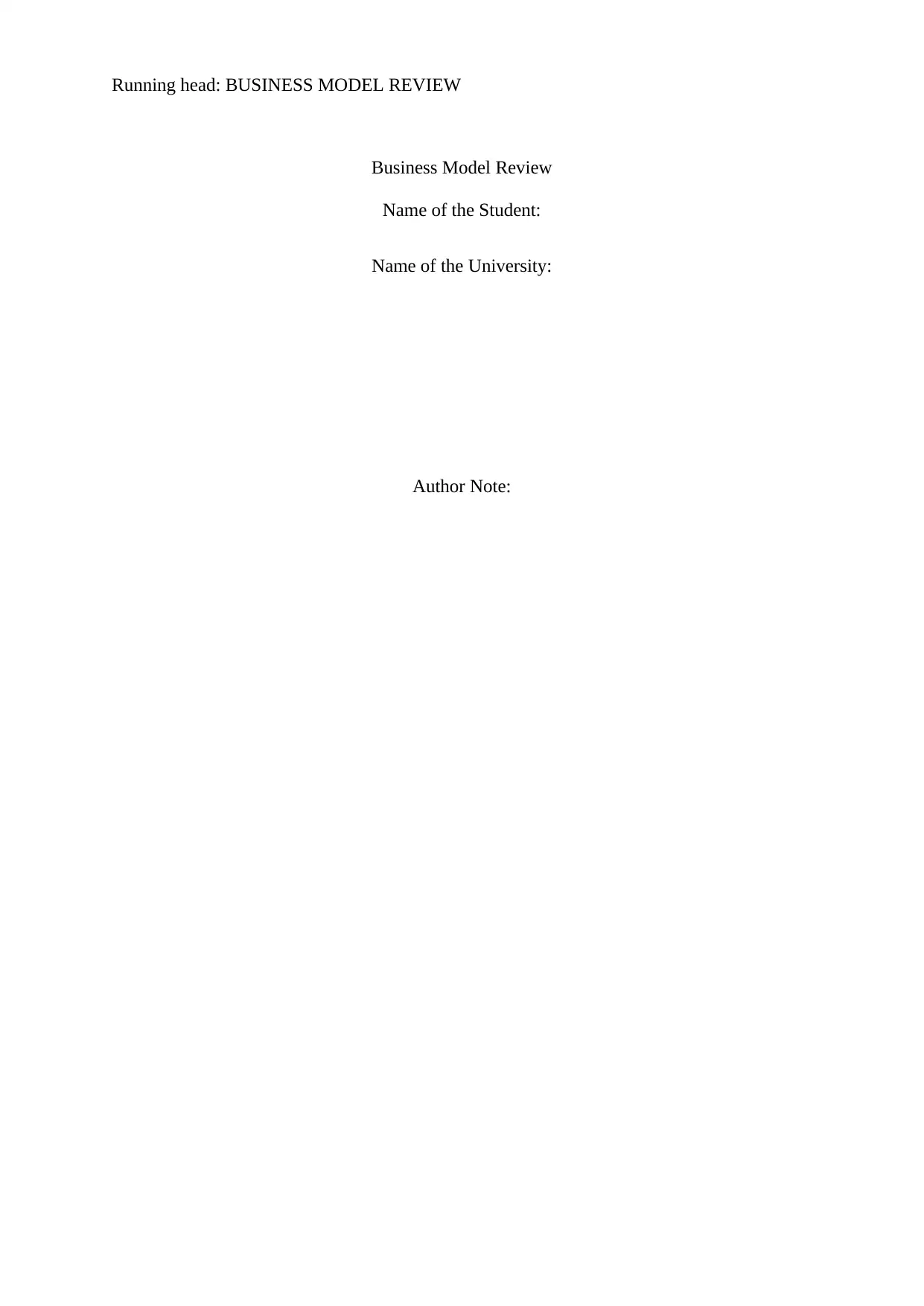
Running head: BUSINESS MODEL REVIEW
Business Model Review
Name of the Student:
Name of the University:
Author Note:
Business Model Review
Name of the Student:
Name of the University:
Author Note:
Paraphrase This Document
Need a fresh take? Get an instant paraphrase of this document with our AI Paraphraser
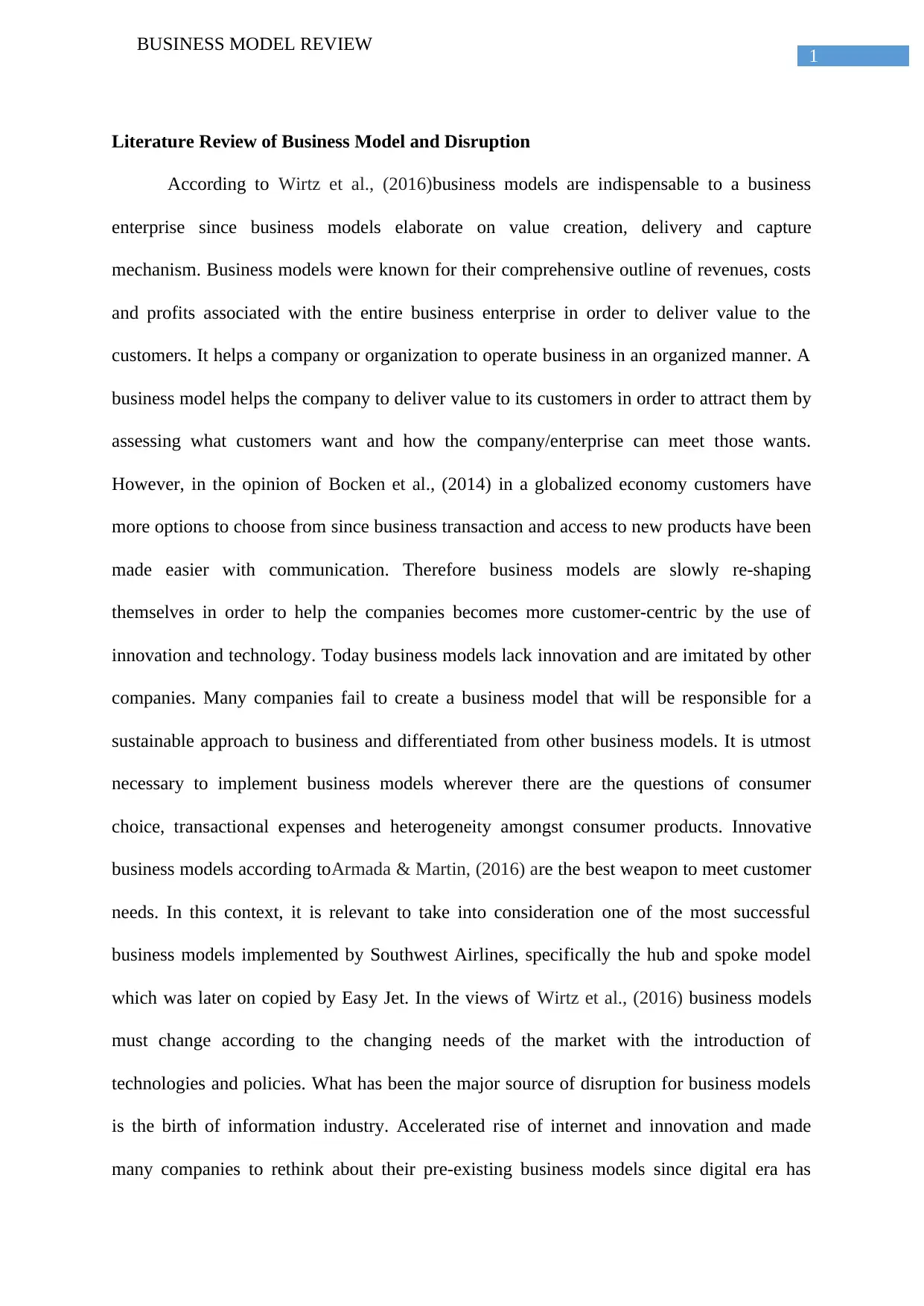
1
BUSINESS MODEL REVIEW
Literature Review of Business Model and Disruption
According to Wirtz et al., (2016)business models are indispensable to a business
enterprise since business models elaborate on value creation, delivery and capture
mechanism. Business models were known for their comprehensive outline of revenues, costs
and profits associated with the entire business enterprise in order to deliver value to the
customers. It helps a company or organization to operate business in an organized manner. A
business model helps the company to deliver value to its customers in order to attract them by
assessing what customers want and how the company/enterprise can meet those wants.
However, in the opinion of Bocken et al., (2014) in a globalized economy customers have
more options to choose from since business transaction and access to new products have been
made easier with communication. Therefore business models are slowly re-shaping
themselves in order to help the companies becomes more customer-centric by the use of
innovation and technology. Today business models lack innovation and are imitated by other
companies. Many companies fail to create a business model that will be responsible for a
sustainable approach to business and differentiated from other business models. It is utmost
necessary to implement business models wherever there are the questions of consumer
choice, transactional expenses and heterogeneity amongst consumer products. Innovative
business models according toArmada & Martin, (2016) are the best weapon to meet customer
needs. In this context, it is relevant to take into consideration one of the most successful
business models implemented by Southwest Airlines, specifically the hub and spoke model
which was later on copied by Easy Jet. In the views of Wirtz et al., (2016) business models
must change according to the changing needs of the market with the introduction of
technologies and policies. What has been the major source of disruption for business models
is the birth of information industry. Accelerated rise of internet and innovation and made
many companies to rethink about their pre-existing business models since digital era has
BUSINESS MODEL REVIEW
Literature Review of Business Model and Disruption
According to Wirtz et al., (2016)business models are indispensable to a business
enterprise since business models elaborate on value creation, delivery and capture
mechanism. Business models were known for their comprehensive outline of revenues, costs
and profits associated with the entire business enterprise in order to deliver value to the
customers. It helps a company or organization to operate business in an organized manner. A
business model helps the company to deliver value to its customers in order to attract them by
assessing what customers want and how the company/enterprise can meet those wants.
However, in the opinion of Bocken et al., (2014) in a globalized economy customers have
more options to choose from since business transaction and access to new products have been
made easier with communication. Therefore business models are slowly re-shaping
themselves in order to help the companies becomes more customer-centric by the use of
innovation and technology. Today business models lack innovation and are imitated by other
companies. Many companies fail to create a business model that will be responsible for a
sustainable approach to business and differentiated from other business models. It is utmost
necessary to implement business models wherever there are the questions of consumer
choice, transactional expenses and heterogeneity amongst consumer products. Innovative
business models according toArmada & Martin, (2016) are the best weapon to meet customer
needs. In this context, it is relevant to take into consideration one of the most successful
business models implemented by Southwest Airlines, specifically the hub and spoke model
which was later on copied by Easy Jet. In the views of Wirtz et al., (2016) business models
must change according to the changing needs of the market with the introduction of
technologies and policies. What has been the major source of disruption for business models
is the birth of information industry. Accelerated rise of internet and innovation and made
many companies to rethink about their pre-existing business models since digital era has
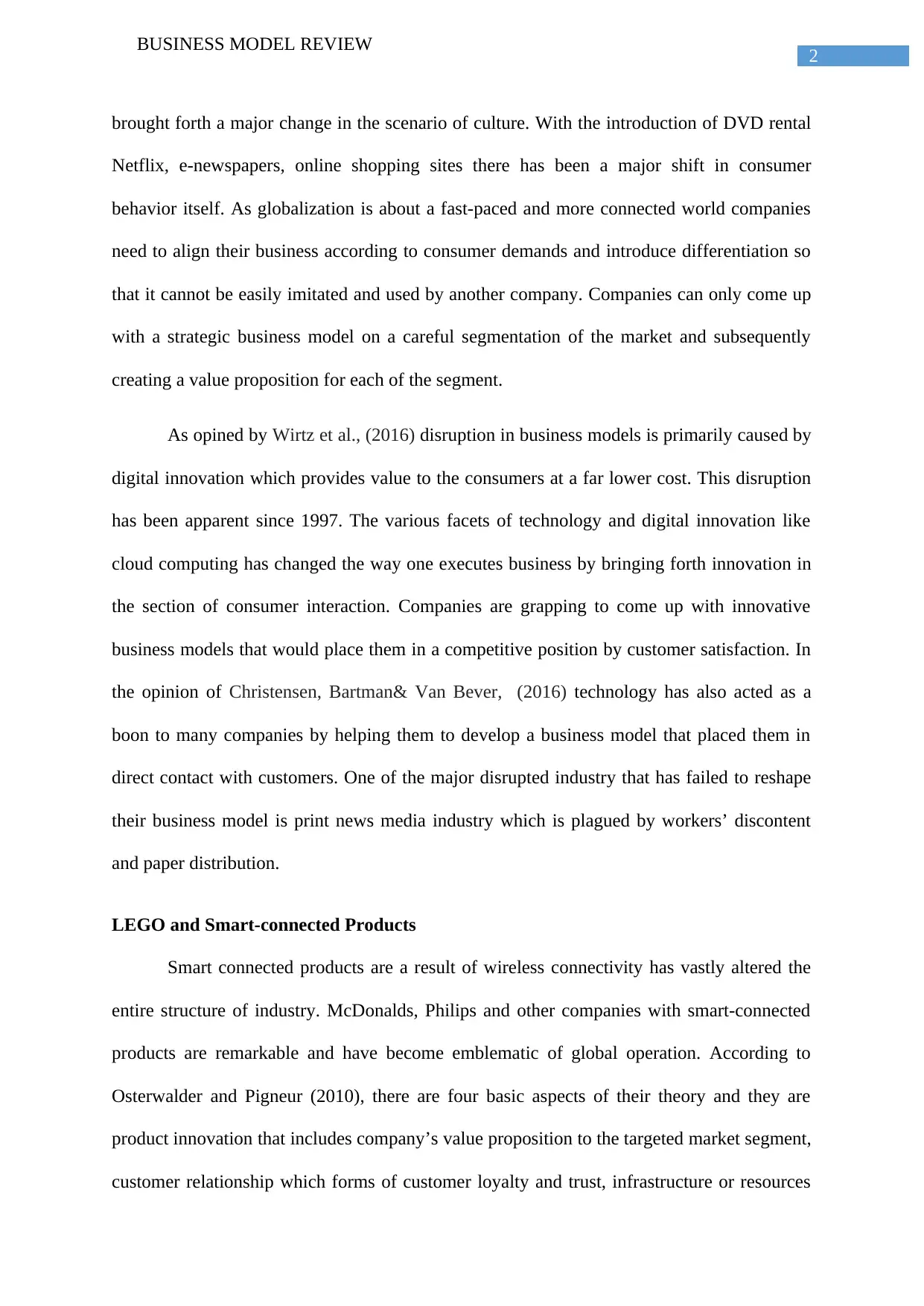
2
BUSINESS MODEL REVIEW
brought forth a major change in the scenario of culture. With the introduction of DVD rental
Netflix, e-newspapers, online shopping sites there has been a major shift in consumer
behavior itself. As globalization is about a fast-paced and more connected world companies
need to align their business according to consumer demands and introduce differentiation so
that it cannot be easily imitated and used by another company. Companies can only come up
with a strategic business model on a careful segmentation of the market and subsequently
creating a value proposition for each of the segment.
As opined by Wirtz et al., (2016) disruption in business models is primarily caused by
digital innovation which provides value to the consumers at a far lower cost. This disruption
has been apparent since 1997. The various facets of technology and digital innovation like
cloud computing has changed the way one executes business by bringing forth innovation in
the section of consumer interaction. Companies are grapping to come up with innovative
business models that would place them in a competitive position by customer satisfaction. In
the opinion of Christensen, Bartman& Van Bever, (2016) technology has also acted as a
boon to many companies by helping them to develop a business model that placed them in
direct contact with customers. One of the major disrupted industry that has failed to reshape
their business model is print news media industry which is plagued by workers’ discontent
and paper distribution.
LEGO and Smart-connected Products
Smart connected products are a result of wireless connectivity has vastly altered the
entire structure of industry. McDonalds, Philips and other companies with smart-connected
products are remarkable and have become emblematic of global operation. According to
Osterwalder and Pigneur (2010), there are four basic aspects of their theory and they are
product innovation that includes company’s value proposition to the targeted market segment,
customer relationship which forms of customer loyalty and trust, infrastructure or resources
BUSINESS MODEL REVIEW
brought forth a major change in the scenario of culture. With the introduction of DVD rental
Netflix, e-newspapers, online shopping sites there has been a major shift in consumer
behavior itself. As globalization is about a fast-paced and more connected world companies
need to align their business according to consumer demands and introduce differentiation so
that it cannot be easily imitated and used by another company. Companies can only come up
with a strategic business model on a careful segmentation of the market and subsequently
creating a value proposition for each of the segment.
As opined by Wirtz et al., (2016) disruption in business models is primarily caused by
digital innovation which provides value to the consumers at a far lower cost. This disruption
has been apparent since 1997. The various facets of technology and digital innovation like
cloud computing has changed the way one executes business by bringing forth innovation in
the section of consumer interaction. Companies are grapping to come up with innovative
business models that would place them in a competitive position by customer satisfaction. In
the opinion of Christensen, Bartman& Van Bever, (2016) technology has also acted as a
boon to many companies by helping them to develop a business model that placed them in
direct contact with customers. One of the major disrupted industry that has failed to reshape
their business model is print news media industry which is plagued by workers’ discontent
and paper distribution.
LEGO and Smart-connected Products
Smart connected products are a result of wireless connectivity has vastly altered the
entire structure of industry. McDonalds, Philips and other companies with smart-connected
products are remarkable and have become emblematic of global operation. According to
Osterwalder and Pigneur (2010), there are four basic aspects of their theory and they are
product innovation that includes company’s value proposition to the targeted market segment,
customer relationship which forms of customer loyalty and trust, infrastructure or resources
⊘ This is a preview!⊘
Do you want full access?
Subscribe today to unlock all pages.

Trusted by 1+ million students worldwide
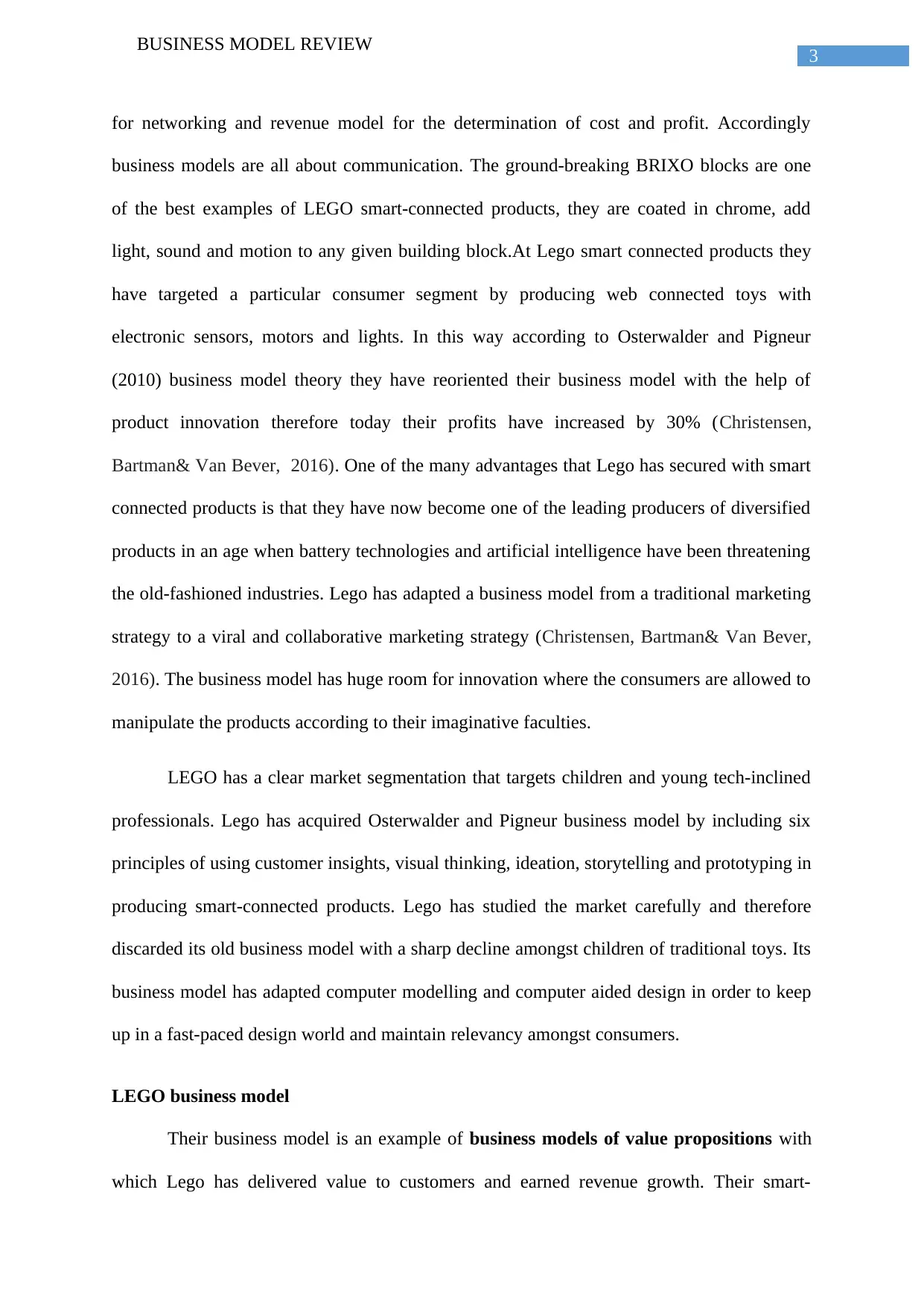
3
BUSINESS MODEL REVIEW
for networking and revenue model for the determination of cost and profit. Accordingly
business models are all about communication. The ground-breaking BRIXO blocks are one
of the best examples of LEGO smart-connected products, they are coated in chrome, add
light, sound and motion to any given building block.At Lego smart connected products they
have targeted a particular consumer segment by producing web connected toys with
electronic sensors, motors and lights. In this way according to Osterwalder and Pigneur
(2010) business model theory they have reoriented their business model with the help of
product innovation therefore today their profits have increased by 30% (Christensen,
Bartman& Van Bever, 2016). One of the many advantages that Lego has secured with smart
connected products is that they have now become one of the leading producers of diversified
products in an age when battery technologies and artificial intelligence have been threatening
the old-fashioned industries. Lego has adapted a business model from a traditional marketing
strategy to a viral and collaborative marketing strategy (Christensen, Bartman& Van Bever,
2016). The business model has huge room for innovation where the consumers are allowed to
manipulate the products according to their imaginative faculties.
LEGO has a clear market segmentation that targets children and young tech-inclined
professionals. Lego has acquired Osterwalder and Pigneur business model by including six
principles of using customer insights, visual thinking, ideation, storytelling and prototyping in
producing smart-connected products. Lego has studied the market carefully and therefore
discarded its old business model with a sharp decline amongst children of traditional toys. Its
business model has adapted computer modelling and computer aided design in order to keep
up in a fast-paced design world and maintain relevancy amongst consumers.
LEGO business model
Their business model is an example of business models of value propositions with
which Lego has delivered value to customers and earned revenue growth. Their smart-
BUSINESS MODEL REVIEW
for networking and revenue model for the determination of cost and profit. Accordingly
business models are all about communication. The ground-breaking BRIXO blocks are one
of the best examples of LEGO smart-connected products, they are coated in chrome, add
light, sound and motion to any given building block.At Lego smart connected products they
have targeted a particular consumer segment by producing web connected toys with
electronic sensors, motors and lights. In this way according to Osterwalder and Pigneur
(2010) business model theory they have reoriented their business model with the help of
product innovation therefore today their profits have increased by 30% (Christensen,
Bartman& Van Bever, 2016). One of the many advantages that Lego has secured with smart
connected products is that they have now become one of the leading producers of diversified
products in an age when battery technologies and artificial intelligence have been threatening
the old-fashioned industries. Lego has adapted a business model from a traditional marketing
strategy to a viral and collaborative marketing strategy (Christensen, Bartman& Van Bever,
2016). The business model has huge room for innovation where the consumers are allowed to
manipulate the products according to their imaginative faculties.
LEGO has a clear market segmentation that targets children and young tech-inclined
professionals. Lego has acquired Osterwalder and Pigneur business model by including six
principles of using customer insights, visual thinking, ideation, storytelling and prototyping in
producing smart-connected products. Lego has studied the market carefully and therefore
discarded its old business model with a sharp decline amongst children of traditional toys. Its
business model has adapted computer modelling and computer aided design in order to keep
up in a fast-paced design world and maintain relevancy amongst consumers.
LEGO business model
Their business model is an example of business models of value propositions with
which Lego has delivered value to customers and earned revenue growth. Their smart-
Paraphrase This Document
Need a fresh take? Get an instant paraphrase of this document with our AI Paraphraser
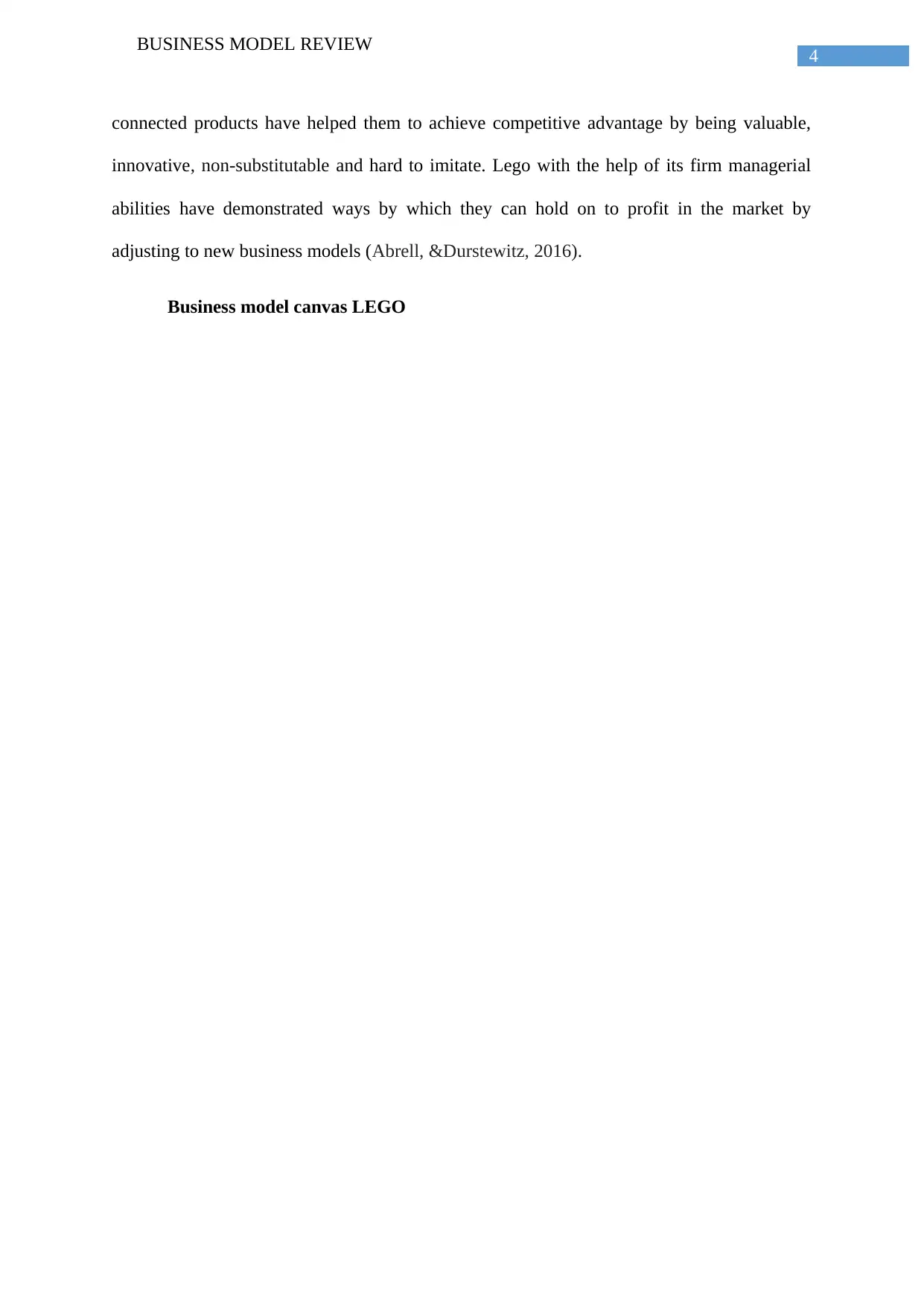
4
BUSINESS MODEL REVIEW
connected products have helped them to achieve competitive advantage by being valuable,
innovative, non-substitutable and hard to imitate. Lego with the help of its firm managerial
abilities have demonstrated ways by which they can hold on to profit in the market by
adjusting to new business models (Abrell, &Durstewitz, 2016).
Business model canvas LEGO
BUSINESS MODEL REVIEW
connected products have helped them to achieve competitive advantage by being valuable,
innovative, non-substitutable and hard to imitate. Lego with the help of its firm managerial
abilities have demonstrated ways by which they can hold on to profit in the market by
adjusting to new business models (Abrell, &Durstewitz, 2016).
Business model canvas LEGO
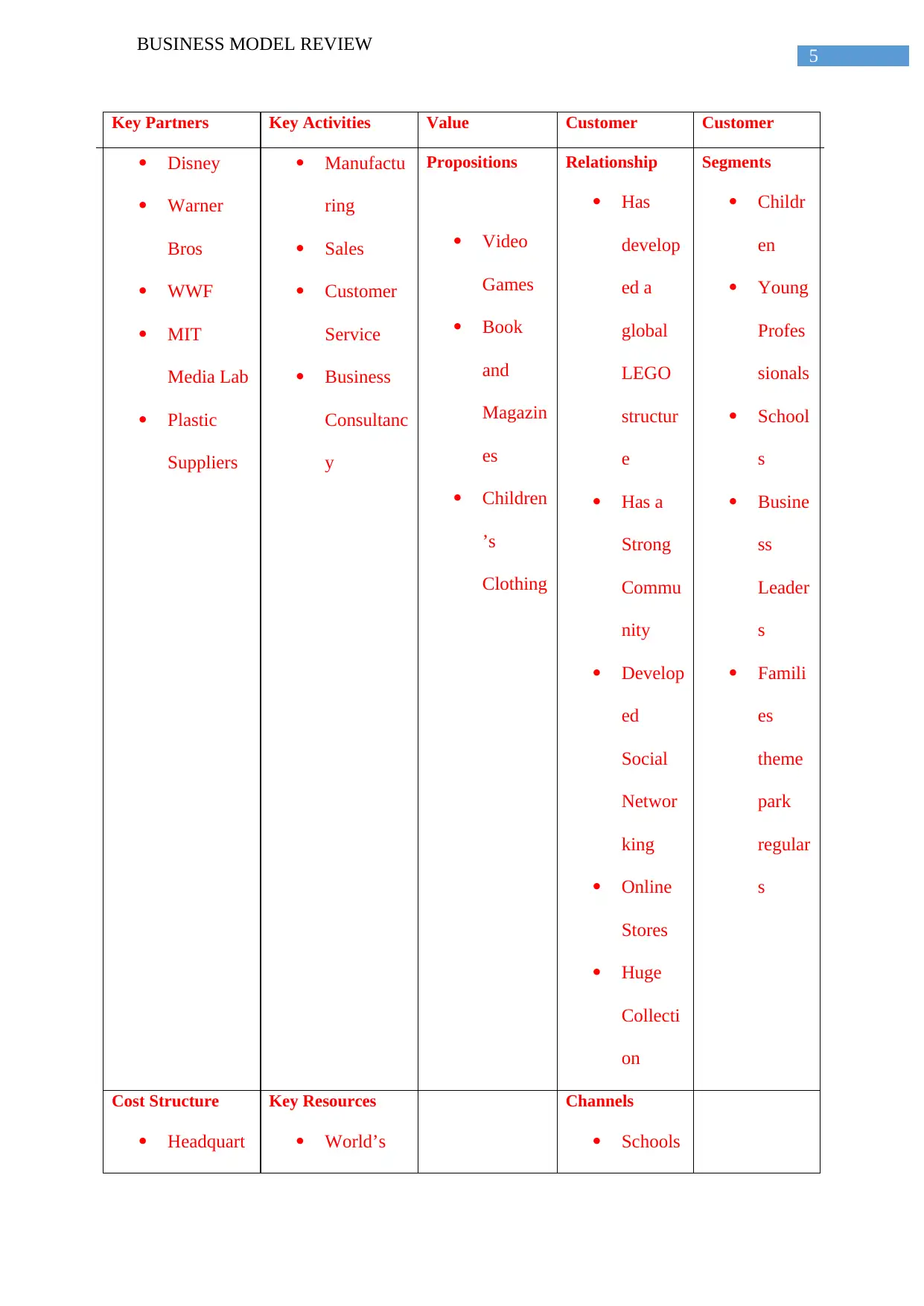
5
BUSINESS MODEL REVIEW
Key Partners
Disney
Warner
Bros
WWF
MIT
Media Lab
Plastic
Suppliers
Key Activities
Manufactu
ring
Sales
Customer
Service
Business
Consultanc
y
Value
Propositions
Video
Games
Book
and
Magazin
es
Children
’s
Clothing
Customer
Relationship
Has
develop
ed a
global
LEGO
structur
e
Has a
Strong
Commu
nity
Develop
ed
Social
Networ
king
Online
Stores
Huge
Collecti
on
Customer
Segments
Childr
en
Young
Profes
sionals
School
s
Busine
ss
Leader
s
Famili
es
theme
park
regular
s
Cost Structure
Headquart
Key Resources
World’s
Channels
Schools
BUSINESS MODEL REVIEW
Key Partners
Disney
Warner
Bros
WWF
MIT
Media Lab
Plastic
Suppliers
Key Activities
Manufactu
ring
Sales
Customer
Service
Business
Consultanc
y
Value
Propositions
Video
Games
Book
and
Magazin
es
Children
’s
Clothing
Customer
Relationship
Has
develop
ed a
global
LEGO
structur
e
Has a
Strong
Commu
nity
Develop
ed
Social
Networ
king
Online
Stores
Huge
Collecti
on
Customer
Segments
Childr
en
Young
Profes
sionals
School
s
Busine
ss
Leader
s
Famili
es
theme
park
regular
s
Cost Structure
Headquart
Key Resources
World’s
Channels
Schools
⊘ This is a preview!⊘
Do you want full access?
Subscribe today to unlock all pages.

Trusted by 1+ million students worldwide
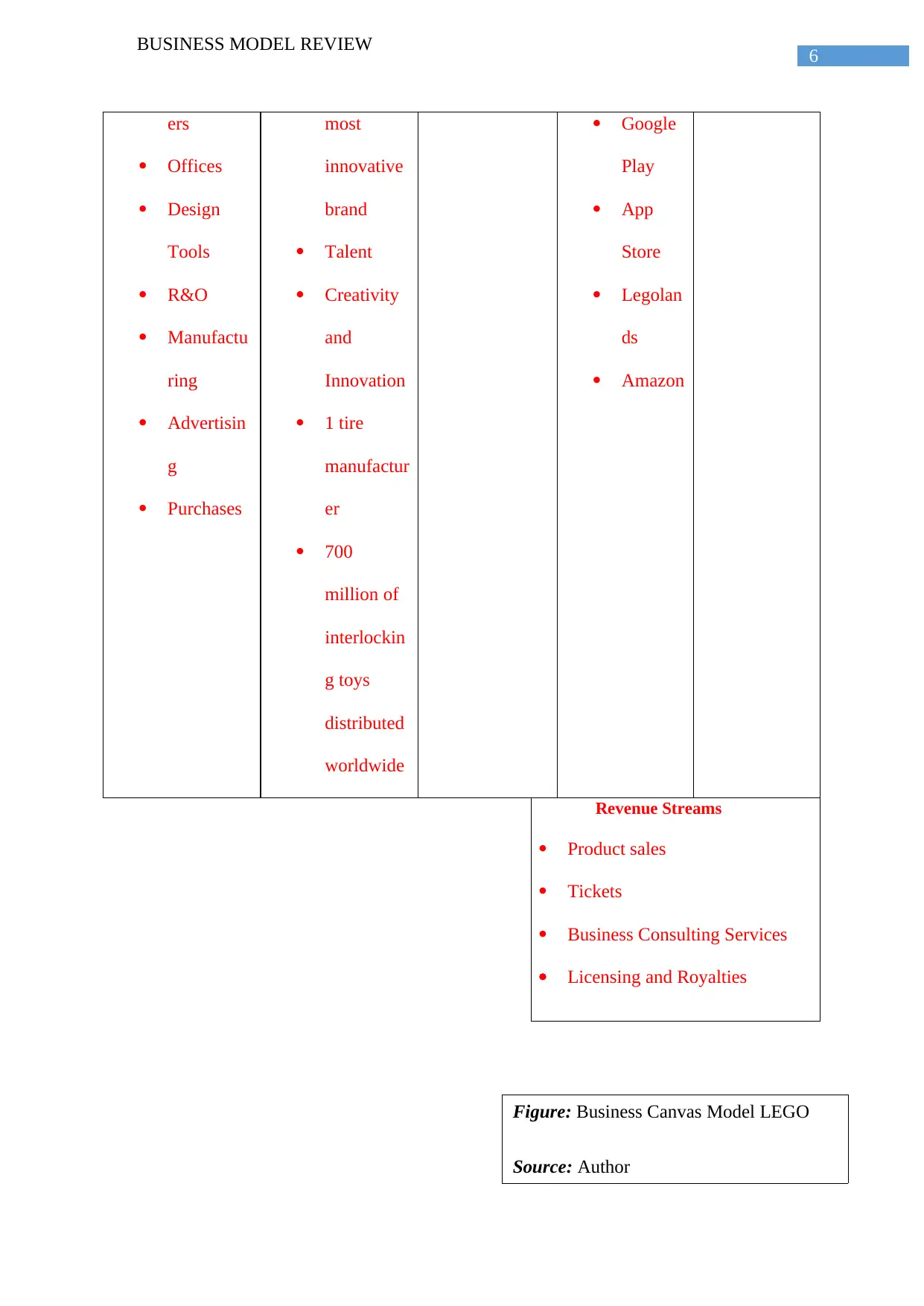
6
BUSINESS MODEL REVIEW
ers
Offices
Design
Tools
R&O
Manufactu
ring
Advertisin
g
Purchases
most
innovative
brand
Talent
Creativity
and
Innovation
1 tire
manufactur
er
700
million of
interlockin
g toys
distributed
worldwide
Google
Play
App
Store
Legolan
ds
Amazon
Revenue Streams
Product sales
Tickets
Business Consulting Services
Licensing and Royalties
Figure: Business Canvas Model LEGO
Source: Author
BUSINESS MODEL REVIEW
ers
Offices
Design
Tools
R&O
Manufactu
ring
Advertisin
g
Purchases
most
innovative
brand
Talent
Creativity
and
Innovation
1 tire
manufactur
er
700
million of
interlockin
g toys
distributed
worldwide
Play
App
Store
Legolan
ds
Amazon
Revenue Streams
Product sales
Tickets
Business Consulting Services
Licensing and Royalties
Figure: Business Canvas Model LEGO
Source: Author
Paraphrase This Document
Need a fresh take? Get an instant paraphrase of this document with our AI Paraphraser
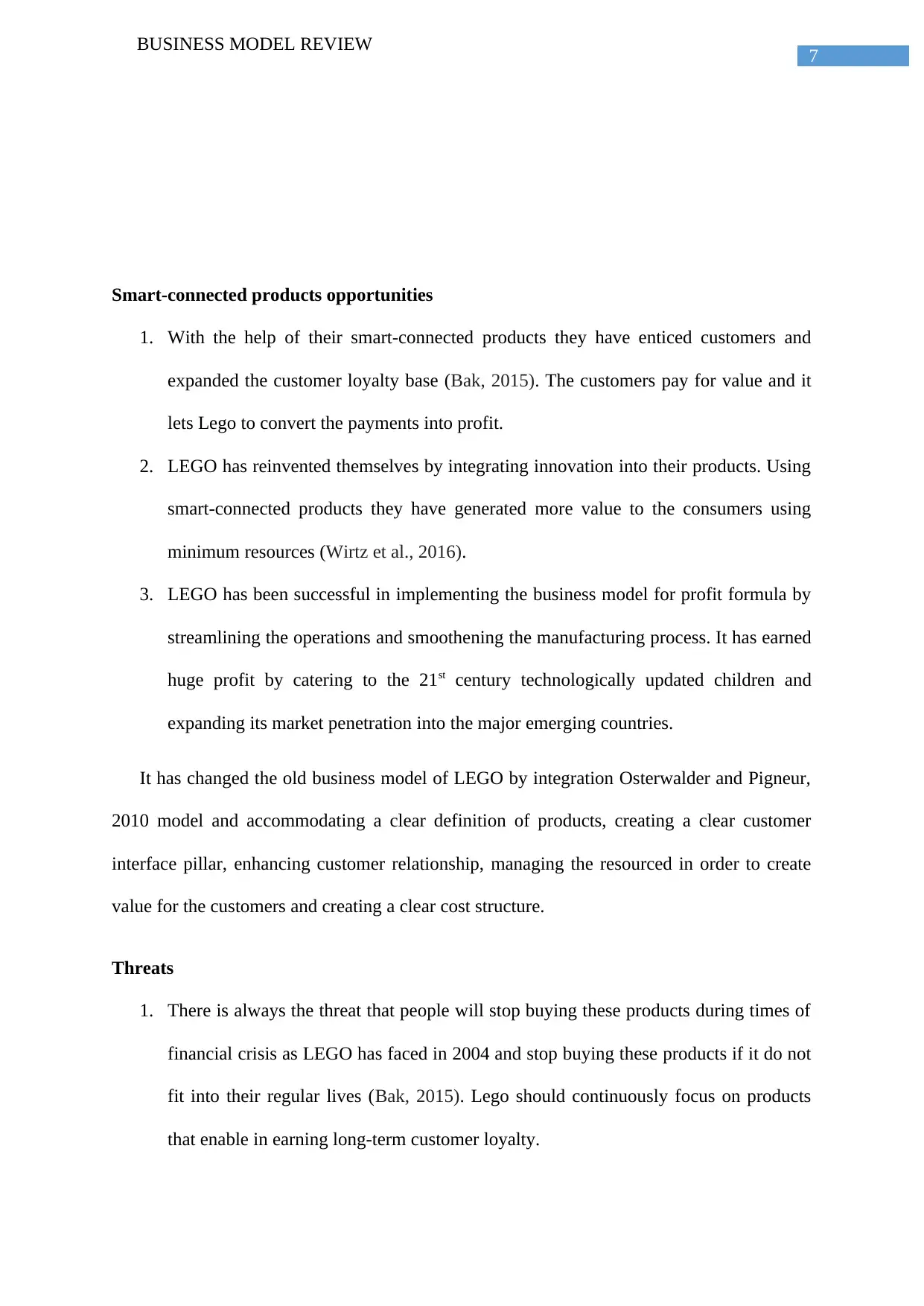
7
BUSINESS MODEL REVIEW
Smart-connected products opportunities
1. With the help of their smart-connected products they have enticed customers and
expanded the customer loyalty base (Bak, 2015). The customers pay for value and it
lets Lego to convert the payments into profit.
2. LEGO has reinvented themselves by integrating innovation into their products. Using
smart-connected products they have generated more value to the consumers using
minimum resources (Wirtz et al., 2016).
3. LEGO has been successful in implementing the business model for profit formula by
streamlining the operations and smoothening the manufacturing process. It has earned
huge profit by catering to the 21st century technologically updated children and
expanding its market penetration into the major emerging countries.
It has changed the old business model of LEGO by integration Osterwalder and Pigneur,
2010 model and accommodating a clear definition of products, creating a clear customer
interface pillar, enhancing customer relationship, managing the resourced in order to create
value for the customers and creating a clear cost structure.
Threats
1. There is always the threat that people will stop buying these products during times of
financial crisis as LEGO has faced in 2004 and stop buying these products if it do not
fit into their regular lives (Bak, 2015). Lego should continuously focus on products
that enable in earning long-term customer loyalty.
BUSINESS MODEL REVIEW
Smart-connected products opportunities
1. With the help of their smart-connected products they have enticed customers and
expanded the customer loyalty base (Bak, 2015). The customers pay for value and it
lets Lego to convert the payments into profit.
2. LEGO has reinvented themselves by integrating innovation into their products. Using
smart-connected products they have generated more value to the consumers using
minimum resources (Wirtz et al., 2016).
3. LEGO has been successful in implementing the business model for profit formula by
streamlining the operations and smoothening the manufacturing process. It has earned
huge profit by catering to the 21st century technologically updated children and
expanding its market penetration into the major emerging countries.
It has changed the old business model of LEGO by integration Osterwalder and Pigneur,
2010 model and accommodating a clear definition of products, creating a clear customer
interface pillar, enhancing customer relationship, managing the resourced in order to create
value for the customers and creating a clear cost structure.
Threats
1. There is always the threat that people will stop buying these products during times of
financial crisis as LEGO has faced in 2004 and stop buying these products if it do not
fit into their regular lives (Bak, 2015). Lego should continuously focus on products
that enable in earning long-term customer loyalty.
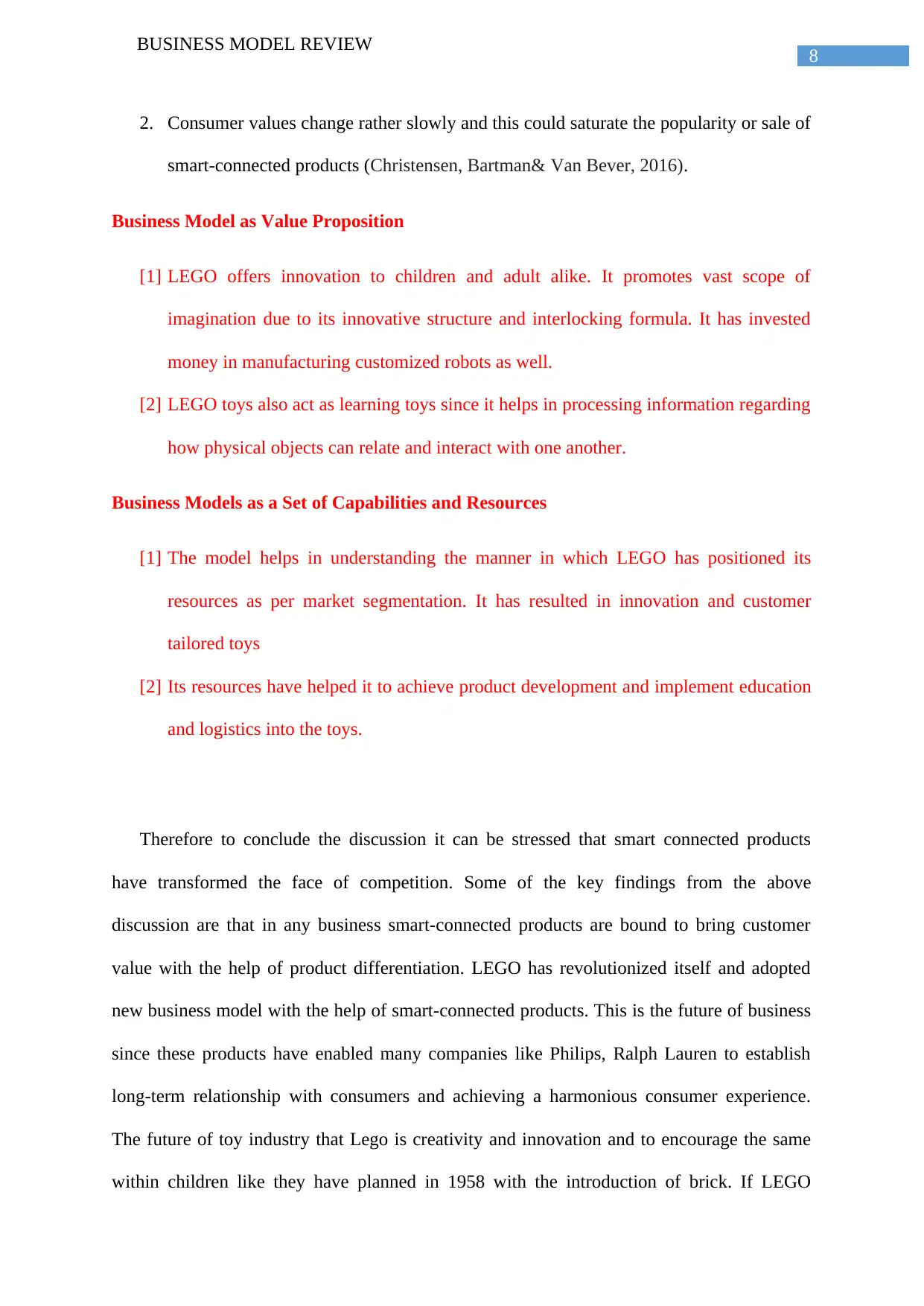
8
BUSINESS MODEL REVIEW
2. Consumer values change rather slowly and this could saturate the popularity or sale of
smart-connected products (Christensen, Bartman& Van Bever, 2016).
Business Model as Value Proposition
[1] LEGO offers innovation to children and adult alike. It promotes vast scope of
imagination due to its innovative structure and interlocking formula. It has invested
money in manufacturing customized robots as well.
[2] LEGO toys also act as learning toys since it helps in processing information regarding
how physical objects can relate and interact with one another.
Business Models as a Set of Capabilities and Resources
[1] The model helps in understanding the manner in which LEGO has positioned its
resources as per market segmentation. It has resulted in innovation and customer
tailored toys
[2] Its resources have helped it to achieve product development and implement education
and logistics into the toys.
Therefore to conclude the discussion it can be stressed that smart connected products
have transformed the face of competition. Some of the key findings from the above
discussion are that in any business smart-connected products are bound to bring customer
value with the help of product differentiation. LEGO has revolutionized itself and adopted
new business model with the help of smart-connected products. This is the future of business
since these products have enabled many companies like Philips, Ralph Lauren to establish
long-term relationship with consumers and achieving a harmonious consumer experience.
The future of toy industry that Lego is creativity and innovation and to encourage the same
within children like they have planned in 1958 with the introduction of brick. If LEGO
BUSINESS MODEL REVIEW
2. Consumer values change rather slowly and this could saturate the popularity or sale of
smart-connected products (Christensen, Bartman& Van Bever, 2016).
Business Model as Value Proposition
[1] LEGO offers innovation to children and adult alike. It promotes vast scope of
imagination due to its innovative structure and interlocking formula. It has invested
money in manufacturing customized robots as well.
[2] LEGO toys also act as learning toys since it helps in processing information regarding
how physical objects can relate and interact with one another.
Business Models as a Set of Capabilities and Resources
[1] The model helps in understanding the manner in which LEGO has positioned its
resources as per market segmentation. It has resulted in innovation and customer
tailored toys
[2] Its resources have helped it to achieve product development and implement education
and logistics into the toys.
Therefore to conclude the discussion it can be stressed that smart connected products
have transformed the face of competition. Some of the key findings from the above
discussion are that in any business smart-connected products are bound to bring customer
value with the help of product differentiation. LEGO has revolutionized itself and adopted
new business model with the help of smart-connected products. This is the future of business
since these products have enabled many companies like Philips, Ralph Lauren to establish
long-term relationship with consumers and achieving a harmonious consumer experience.
The future of toy industry that Lego is creativity and innovation and to encourage the same
within children like they have planned in 1958 with the introduction of brick. If LEGO
⊘ This is a preview!⊘
Do you want full access?
Subscribe today to unlock all pages.

Trusted by 1+ million students worldwide
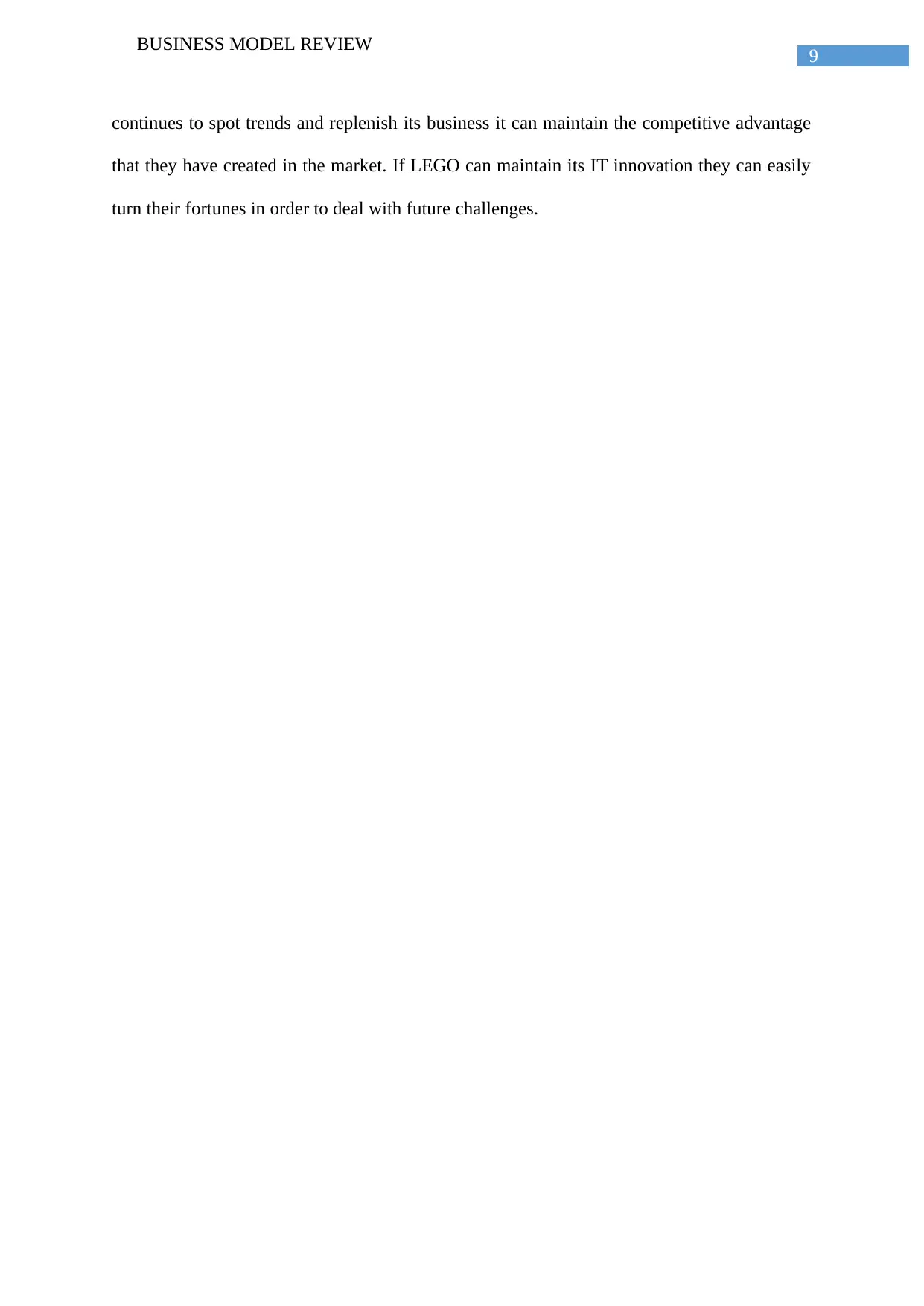
9
BUSINESS MODEL REVIEW
continues to spot trends and replenish its business it can maintain the competitive advantage
that they have created in the market. If LEGO can maintain its IT innovation they can easily
turn their fortunes in order to deal with future challenges.
BUSINESS MODEL REVIEW
continues to spot trends and replenish its business it can maintain the competitive advantage
that they have created in the market. If LEGO can maintain its IT innovation they can easily
turn their fortunes in order to deal with future challenges.
Paraphrase This Document
Need a fresh take? Get an instant paraphrase of this document with our AI Paraphraser
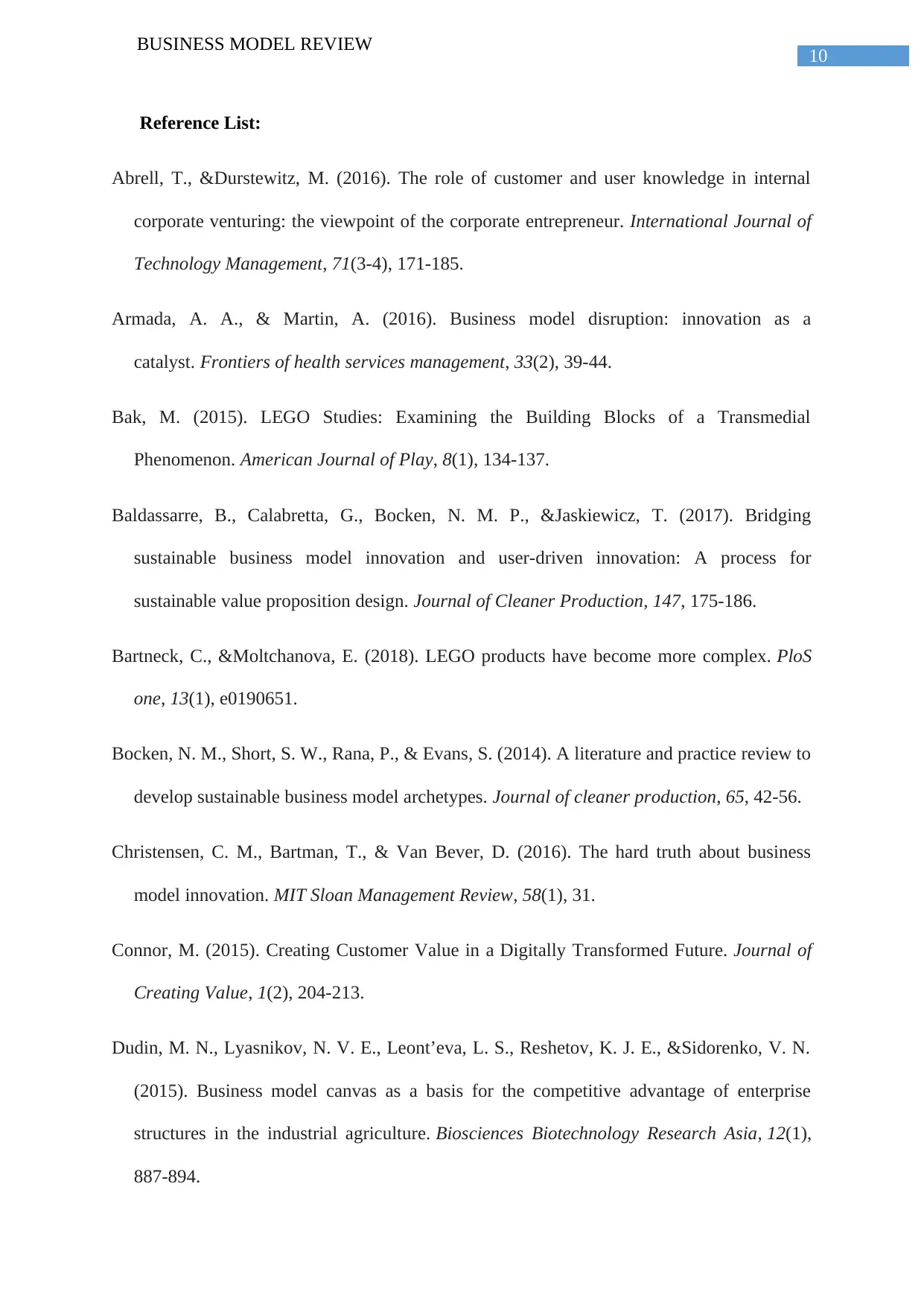
10
BUSINESS MODEL REVIEW
Reference List:
Abrell, T., &Durstewitz, M. (2016). The role of customer and user knowledge in internal
corporate venturing: the viewpoint of the corporate entrepreneur. International Journal of
Technology Management, 71(3-4), 171-185.
Armada, A. A., & Martin, A. (2016). Business model disruption: innovation as a
catalyst. Frontiers of health services management, 33(2), 39-44.
Bak, M. (2015). LEGO Studies: Examining the Building Blocks of a Transmedial
Phenomenon. American Journal of Play, 8(1), 134-137.
Baldassarre, B., Calabretta, G., Bocken, N. M. P., &Jaskiewicz, T. (2017). Bridging
sustainable business model innovation and user-driven innovation: A process for
sustainable value proposition design. Journal of Cleaner Production, 147, 175-186.
Bartneck, C., &Moltchanova, E. (2018). LEGO products have become more complex. PloS
one, 13(1), e0190651.
Bocken, N. M., Short, S. W., Rana, P., & Evans, S. (2014). A literature and practice review to
develop sustainable business model archetypes. Journal of cleaner production, 65, 42-56.
Christensen, C. M., Bartman, T., & Van Bever, D. (2016). The hard truth about business
model innovation. MIT Sloan Management Review, 58(1), 31.
Connor, M. (2015). Creating Customer Value in a Digitally Transformed Future. Journal of
Creating Value, 1(2), 204-213.
Dudin, M. N., Lyasnikov, N. V. E., Leont’eva, L. S., Reshetov, K. J. E., &Sidorenko, V. N.
(2015). Business model canvas as a basis for the competitive advantage of enterprise
structures in the industrial agriculture. Biosciences Biotechnology Research Asia, 12(1),
887-894.
BUSINESS MODEL REVIEW
Reference List:
Abrell, T., &Durstewitz, M. (2016). The role of customer and user knowledge in internal
corporate venturing: the viewpoint of the corporate entrepreneur. International Journal of
Technology Management, 71(3-4), 171-185.
Armada, A. A., & Martin, A. (2016). Business model disruption: innovation as a
catalyst. Frontiers of health services management, 33(2), 39-44.
Bak, M. (2015). LEGO Studies: Examining the Building Blocks of a Transmedial
Phenomenon. American Journal of Play, 8(1), 134-137.
Baldassarre, B., Calabretta, G., Bocken, N. M. P., &Jaskiewicz, T. (2017). Bridging
sustainable business model innovation and user-driven innovation: A process for
sustainable value proposition design. Journal of Cleaner Production, 147, 175-186.
Bartneck, C., &Moltchanova, E. (2018). LEGO products have become more complex. PloS
one, 13(1), e0190651.
Bocken, N. M., Short, S. W., Rana, P., & Evans, S. (2014). A literature and practice review to
develop sustainable business model archetypes. Journal of cleaner production, 65, 42-56.
Christensen, C. M., Bartman, T., & Van Bever, D. (2016). The hard truth about business
model innovation. MIT Sloan Management Review, 58(1), 31.
Connor, M. (2015). Creating Customer Value in a Digitally Transformed Future. Journal of
Creating Value, 1(2), 204-213.
Dudin, M. N., Lyasnikov, N. V. E., Leont’eva, L. S., Reshetov, K. J. E., &Sidorenko, V. N.
(2015). Business model canvas as a basis for the competitive advantage of enterprise
structures in the industrial agriculture. Biosciences Biotechnology Research Asia, 12(1),
887-894.
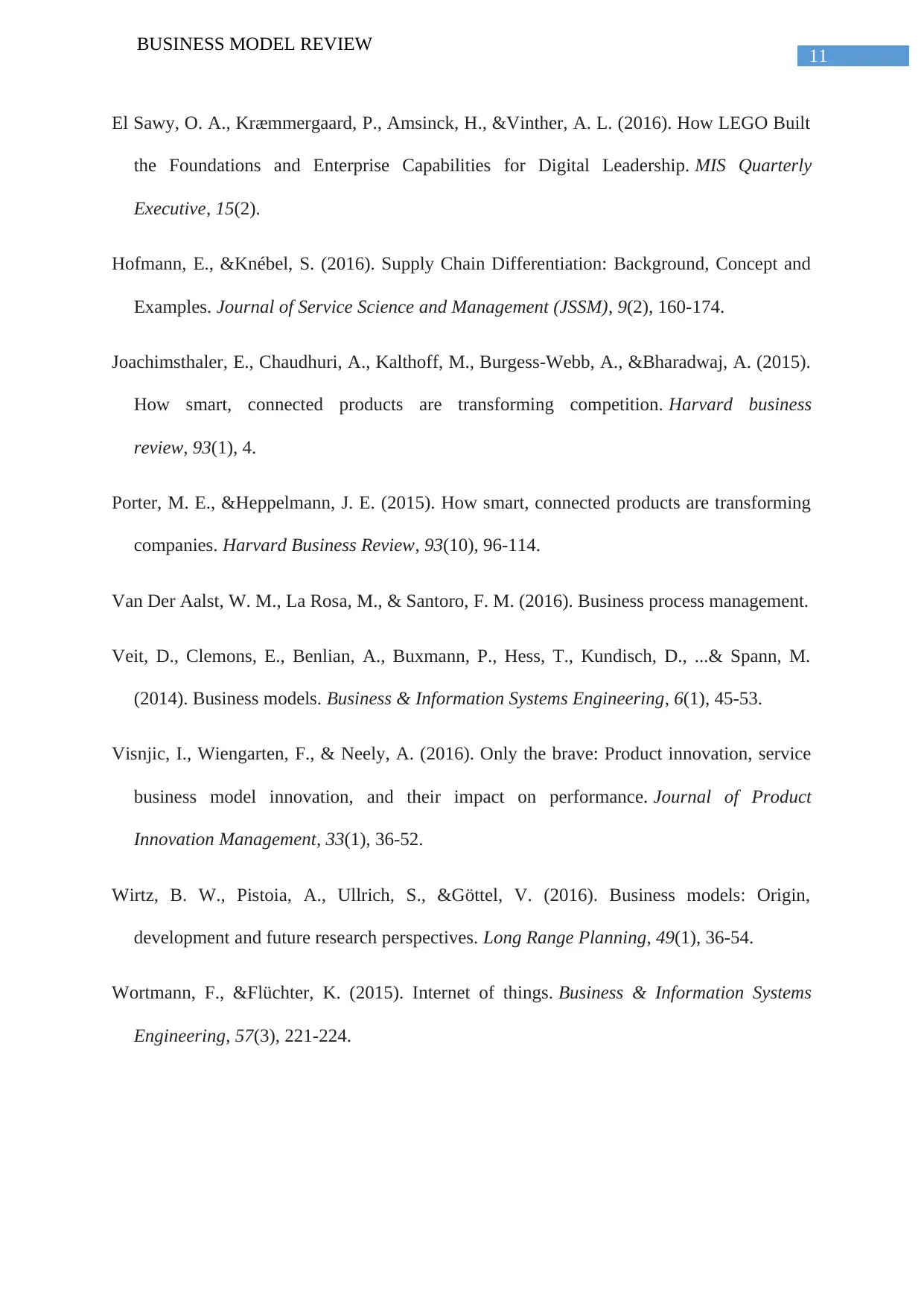
11
BUSINESS MODEL REVIEW
El Sawy, O. A., Kræmmergaard, P., Amsinck, H., &Vinther, A. L. (2016). How LEGO Built
the Foundations and Enterprise Capabilities for Digital Leadership. MIS Quarterly
Executive, 15(2).
Hofmann, E., &Knébel, S. (2016). Supply Chain Differentiation: Background, Concept and
Examples. Journal of Service Science and Management (JSSM), 9(2), 160-174.
Joachimsthaler, E., Chaudhuri, A., Kalthoff, M., Burgess-Webb, A., &Bharadwaj, A. (2015).
How smart, connected products are transforming competition. Harvard business
review, 93(1), 4.
Porter, M. E., &Heppelmann, J. E. (2015). How smart, connected products are transforming
companies. Harvard Business Review, 93(10), 96-114.
Van Der Aalst, W. M., La Rosa, M., & Santoro, F. M. (2016). Business process management.
Veit, D., Clemons, E., Benlian, A., Buxmann, P., Hess, T., Kundisch, D., ...& Spann, M.
(2014). Business models. Business & Information Systems Engineering, 6(1), 45-53.
Visnjic, I., Wiengarten, F., & Neely, A. (2016). Only the brave: Product innovation, service
business model innovation, and their impact on performance. Journal of Product
Innovation Management, 33(1), 36-52.
Wirtz, B. W., Pistoia, A., Ullrich, S., &Göttel, V. (2016). Business models: Origin,
development and future research perspectives. Long Range Planning, 49(1), 36-54.
Wortmann, F., &Flüchter, K. (2015). Internet of things. Business & Information Systems
Engineering, 57(3), 221-224.
BUSINESS MODEL REVIEW
El Sawy, O. A., Kræmmergaard, P., Amsinck, H., &Vinther, A. L. (2016). How LEGO Built
the Foundations and Enterprise Capabilities for Digital Leadership. MIS Quarterly
Executive, 15(2).
Hofmann, E., &Knébel, S. (2016). Supply Chain Differentiation: Background, Concept and
Examples. Journal of Service Science and Management (JSSM), 9(2), 160-174.
Joachimsthaler, E., Chaudhuri, A., Kalthoff, M., Burgess-Webb, A., &Bharadwaj, A. (2015).
How smart, connected products are transforming competition. Harvard business
review, 93(1), 4.
Porter, M. E., &Heppelmann, J. E. (2015). How smart, connected products are transforming
companies. Harvard Business Review, 93(10), 96-114.
Van Der Aalst, W. M., La Rosa, M., & Santoro, F. M. (2016). Business process management.
Veit, D., Clemons, E., Benlian, A., Buxmann, P., Hess, T., Kundisch, D., ...& Spann, M.
(2014). Business models. Business & Information Systems Engineering, 6(1), 45-53.
Visnjic, I., Wiengarten, F., & Neely, A. (2016). Only the brave: Product innovation, service
business model innovation, and their impact on performance. Journal of Product
Innovation Management, 33(1), 36-52.
Wirtz, B. W., Pistoia, A., Ullrich, S., &Göttel, V. (2016). Business models: Origin,
development and future research perspectives. Long Range Planning, 49(1), 36-54.
Wortmann, F., &Flüchter, K. (2015). Internet of things. Business & Information Systems
Engineering, 57(3), 221-224.
⊘ This is a preview!⊘
Do you want full access?
Subscribe today to unlock all pages.

Trusted by 1+ million students worldwide
1 out of 12
Related Documents
Your All-in-One AI-Powered Toolkit for Academic Success.
+13062052269
info@desklib.com
Available 24*7 on WhatsApp / Email
![[object Object]](/_next/static/media/star-bottom.7253800d.svg)
Unlock your academic potential
Copyright © 2020–2025 A2Z Services. All Rights Reserved. Developed and managed by ZUCOL.


